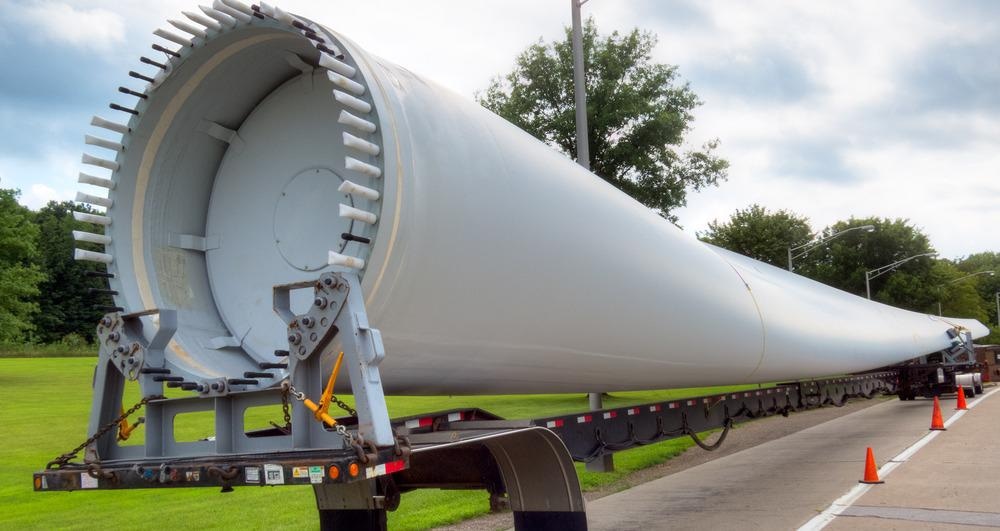Vestas is spearheading a game-changing project to commercialize a novel process that will enable wind turbine blades to be fully recyclable.

The CETEC project being led by Vestas will enable the circular economy of wind turbine blades. Image Credit: Anton Foltin/Shutterstock.com
Working in collaboration with a team of industry and academic experts, Vestas leads the Circular Economic for Thermosets Epoxy Composites (CETEC) project to enable a fully circular economy across the global wind sector.
Tackling the Challenge of Recycling Wind Turbine Blades
As first-generation turbines begin to reach the end of their operational life, fundamental questions are being asked about the environmental impact that the waste generated from decommissioning could present. With 85-90% of wind turbine components classed as recyclable material, the CETEC project aims to close the recycling gap by processing the turbine blade material, which is not currently treated as reusable.
Wind turbine blades present a specific challenge at end-of-life as the complexity of thermoset composites, the material used to make the blades, renders the materials challenging to recycle. This is due to the strong bonding between the epoxy and fiber materials. This is also the feature that governs the low-weight and high-strength properties of these composites.
With properties that allow longer and lighter blades, composites have become an attractive material to turbine manufacturers, with approximately 2.5 million tons in use globally across the wind sector.
Why Thousands of Wind Turbine Blades Wind Up in Landfills
Video Credit: Bloomberg Markets and Finance/YouTube.com
CETEC Project and Two-Step Process
The new technique that would enable circularity for thermoset composites has been developed as part of the DreamWind initiative. This innovation program involved Vestas, the Danish wind turbine manufacturer; Aarhus University; the Danish Technological Institute (DTI); and Olin, the leading epoxy manufacturer.
Driven by the same experts, the CETEC project aims to commercialize the process developed under the DreamWind initiative and advance a fully recyclable wind turbine value chain.
The new technology involves a two-step process. The thermoset composites from wind turbine blades are dissembled into the constituent fiber and epoxy in the first stage. Next, the epoxy is broken down further into base components similar to virgin materials in the second step via a novel chemcycling process. This method allows the reuse of recycled materials for new turbine blade manufacture, creating a circularity pathway for epoxy resin.
Simon Frølich, Team Manager from the Danish Technological Institute, described CETEC’s innovative process as a “gamechanger” for the industry.
The chemcycling process deconstructs the highly stable polymer chains of epoxy-based materials into molecular components. These components are easily processable and can be incorporated into the production of new epoxy resin. This new technique recovers material without losing valuable molecular complexity, allowing new epoxy resins to be produced with no loss in quality.
CETEC’s Commitment to Recycling Solutions
A vital goal of the CETEC project is to deliver an industry-ready solution for broader adoption within three years.
Allan Korsgaard Poulsen, head of Sustainability and Advanced Materials from Vestas Innovation and Concepts, states: “As global commitments to a net-zero future increase, it’s absolutely crucial to ensure the wind industry can scale sustainably, which includes Vestas fulfilling our ambition to produce zero-waste turbines by 2040. Leveraging this new technological breakthrough in chemcycling epoxy resin, the CETEC project will be a significant milestone in Vestas’ journey towards achieving this goal, and in enabling a future where landfill is no longer required in blade decommissioning”.
To develop technologies which close an existing gap of thermosets by creating a circularity is yet another example of putting our Resource Efficiency sustainability goal into action. This innovation will help the industry to minimize consumption of virgin material sources and increase the reuse and recycling of materials.”
Leif Ole Meyer, TS&D Leader EMEAI at Olin
Commercial Impact of CETEC’s Solution
Today, the primary method for composite recycling is cement co-processing, where composites partially replace some of the cement raw materials and the fuel used for the process. CETEC’s solution, therefore, has significant potential to improve the value gained from end-of-life composite materials and enable a circular economy within the wind industry.
The wind turbine blade recycling technology from CETEC could introduce new recycling solutions to industries beyond the wind sector where alternative recycling technologies, such as solvolysis and pyrolysis, have yet to be industrialized at scale.
Vestas says the new technology “holds significant potential for commercial value capture” for manufacturing industries where there is an ever-increasing focus on sustainability and stricter regulations imposed on waste management.
Once the technology has been fully scoped and ready for industrial adoption, it could have applications in other industries, such as aviation and automotive, where thermoset composites are commonly used.
The Future of Zero-Waste Turbines
With 14,000 wind turbine blades due to be decommissioned in Europe between 2020 and 2025, rapid action and ambition are needed to address the imminent end-of-life issues facing aging wind farms.
By advancing technology and overcoming the current limitations in recycling techniques, CETEC’s new blade-recycling process could truly enable a zero-waste circular economy across the wind sector and allow turbines to be sustainably manufactured at scale.
References and Further Reading
Vestas (2021). New coalition of industry and academia to commercialise solution for full recyclability of wind turbine blades. [Online] Available at: https://www.vestas.com/en/media/company-news?n=3974601 [Accessed on 10 June 2021].
Wind Europe (2020). Circular Economy: Blade recycling is a top priority for the wind industry. [Online] Available at: https://windeurope.org/newsroom/news/blade-recycling-a-top-priority-for-the-wind-industry/ [Accessed on 10 June 2021].
Disclaimer: The views expressed here are those of the author expressed in their private capacity and do not necessarily represent the views of AZoM.com Limited T/A AZoNetwork the owner and operator of this website. This disclaimer forms part of the Terms and conditions of use of this website.